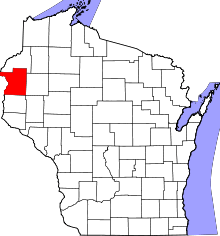Clayton (village), Wisconsin
| Clayton, Wisconsin | |
|---|---|
| Village | |
 Location of Clayton, Polk County, Wisconsin | |
| Coordinates: 45°19′36″N 92°10′23″W / 45.32667°N 92.17306°WCoordinates: 45°19′36″N 92°10′23″W / 45.32667°N 92.17306°W | |
| Country | United States |
| State | Wisconsin |
| County | Polk |
| Area[1] | |
| • Total | 3.24 sq mi (8.39 km2) |
| • Land | 3.11 sq mi (8.05 km2) |
| • Water | 0.13 sq mi (0.34 km2) |
| Elevation[2] | 1,211 ft (369 m) |
| Population (2010)[3] | |
| • Total | 571 |
| • Estimate (2012[4]) | 559 |
| • Density | 183.6/sq mi (70.9/km2) |
| Time zone | Central (CST) (UTC-6) |
| • Summer (DST) | CDT (UTC-5) |
| Area code(s) | 715 & 534 |
| FIPS code | 55-15100[5] |
| GNIS feature ID | 1563136[2] |
Clayton is a village in Polk County, Wisconsin, United States. The population was 571 at the 2010 census. The village is located within the Town of Clayton.
History
A post office called Clayton has been in operation since 1876.[6] The village was named for Clayton Rodgers, foreman at a local mill.[7]
Geography
Clayton is located at 45°19′36″N 92°10′23″W / 45.326659°N 92.172985°W (45.326659, -92.172985).[8]
According to the United States Census Bureau, the village has a total area of 3.24 square miles (8.39 km2), of which, 3.11 square miles (8.05 km2) of it is land and 0.13 square miles (0.34 km2) is water.[1]
Demographics
2010 census
As of the census[3] of 2010, there were 571 people, 208 households, and 149 families residing in the village. The population density was 183.6 inhabitants per square mile (70.9/km2). There were 225 housing units at an average density of 72.3 per square mile (27.9/km2). The racial makeup of the village was 96.0% White, 0.7% African American, 0.2% Native American, 1.2% from other races, and 1.9% from two or more races. Hispanic or Latino of any race were 2.1% of the population.
There were 208 households of which 48.6% had children under the age of 18 living with them, 39.9% were married couples living together, 24.0% had a female householder with no husband present, 7.7% had a male householder with no wife present, and 28.4% were non-families. 24.0% of all households were made up of individuals and 7.2% had someone living alone who was 65 years of age or older. The average household size was 2.75 and the average family size was 3.10.
The median age in the village was 29.1 years. 33.6% of residents were under the age of 18; 11.5% were between the ages of 18 and 24; 27.5% were from 25 to 44; 19.8% were from 45 to 64; and 7.7% were 65 years of age or older. The gender makeup of the village was 49.2% male and 50.8% female.
2000 census
As of the census[5] of 2000, there were 507 people, 199 households, and 125 families residing in the village. The population density was 162.6 people per square mile (62.7/km2). There were 208 housing units at an average density of 66.7/sq mi (25.7/km2). The racial makeup of the village was 97.83% White, 1.18% Black or African American, 0.20% Native American, 0.20% Asian, and 0.59% from two or more races. 0.00% of the population were Hispanic or Latino of any race.
There were 199 households out of which 38.7% had children under the age of 18 living with them, 42.2% were married couples living together, 14.1% had a female householder with no husband present, and 36.7% were non-families. 29.1% of all households were made up of individuals and 14.1% had someone living alone who was 65 years of age or older. The average household size was 2.55 and the average family size was 3.15.
In the village the population was spread out with 32.0% under the age of 18, 9.7% from 18 to 24, 32.9% from 25 to 44, 15.8% from 45 to 64, and 9.7% who were 65 years of age or older. The median age was 30 years. For every 100 females there were 93.5 males. For every 100 females age 18 and over, there were 94.9 males.
The median income for a household in the village was $29,135, and the median income for a family was $34,375. Males had a median income of $29,583 versus $22,500 for females. The per capita income for the village was $14,988. About 10.6% of families and 18.7% of the population were below the poverty line, including 25.2% of those under age 18 and 14.5% of those age 65 or over.
References
- 1 2 "US Gazetteer files 2010". United States Census Bureau. Archived from the original on 2012-06-26. Retrieved 2012-11-18.
- 1 2 "US Board on Geographic Names". United States Geological Survey. 2007-10-25. Retrieved 2008-01-31.
- 1 2 "American FactFinder". United States Census Bureau. Retrieved 2012-11-18.
- ↑ "Population Estimates". United States Census Bureau. Archived from the original on 2013-06-17. Retrieved 2013-06-24.
- 1 2 "American FactFinder". United States Census Bureau. Archived from the original on 2013-09-11. Retrieved 2008-01-31.
- ↑ "Polk County". Jim Forte Postal History. Retrieved 3 April 2015.
- ↑ Chicago and North Western Railway Company (1908). A History of the Origin of the Place Names Connected with the Chicago & North Western and Chicago, St. Paul, Minneapolis & Omaha Railways. p. 171.
- ↑ "US Gazetteer files: 2010, 2000, and 1990". United States Census Bureau. 2011-02-12. Retrieved 2011-04-23.
